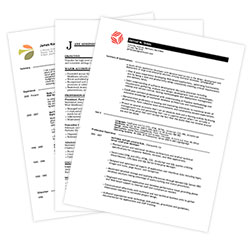 The overall look and feel of your resume may seem trivial compared to what your resume says, but it’s not. Visual elements such as font type, size, and style, along with margins and indents, make a difference for first impressions. You can have all of the necessary information in the right order, but if your resume looks like an illegible block of text, you won't make it to the interview phase of your job search.
The overall look and feel of your resume may seem trivial compared to what your resume says, but it’s not. Visual elements such as font type, size, and style, along with margins and indents, make a difference for first impressions. You can have all of the necessary information in the right order, but if your resume looks like an illegible block of text, you won't make it to the interview phase of your job search.
To avoid that kind of mess, make sure you've nailed the most basic style choices that will appeal to the widest possible range of hiring managers. Here are a few guidelines for creating a resume that’s readable and inviting:
Font: Stick with clean fonts like Verdana, Arial, Trebuchet, or Tahoma.
Font Size: Stay within the 9pt to 12pt range (never higher or lower). Play around with the size of the typeface you choose, since 10pt in one type can be bigger than 10pt in another (funny how that works, huh?). Section headings can be a few points larger than the body text so they're easy to find at a glance.
Font Style: Use bold or italics to make certain parts of your resume stand out. But whatever you do, make sure you're consistent—if you italicize one job title, make sure to italicize them all! Also pay attention to punctuation and line spacing.
Margins: Keep the margins between .5" and 1". Sometimes, a slight adjustment of your margins can eliminate the problem of a second page with only a few lines of text on it..
Indents: The most important thing to remember is to keep all indents aligned vertically down the page. If you indent your bullet lists, make sure all bullet lists have the same indent.
Pongo's Resume Builder makes formatting your resume a no-brainer. All of our resume (and cover letter) templates are designed to be attractive and readable, so you don't have to worry about sending out a poorly constructed resume. But whether you use Pongo or not, be sure your layout and style choices showcase the content of your resume. Don't try to hide a poorly written resume under fancy text and over-the-top graphics, because hiring managers won’t be fooled. A resume that’s clean, readable, and targeted to the job is the best way to stand out from the crowd.
RELATED LINKS
Resume Writing Basics: Building Blocks of a Good Resume
How to Create a Generic, Useless, Well Written Resume
Plain Text Resumes: How to Make Them a Little Less Ugly
How to Make Your Resume Visually Appetizing
Ready To Jump Start Your Job Search?
